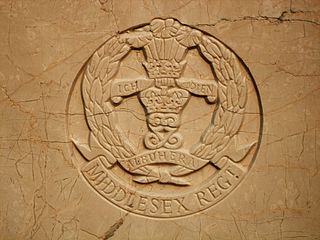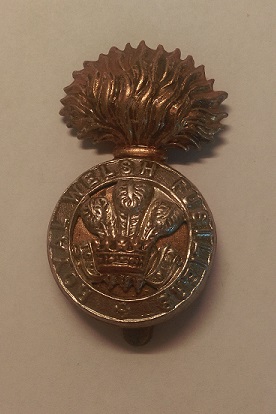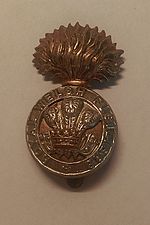The 92nd (Loyals) Light Anti-Aircraft Regiment was a mobile air defence unit of the British Army's Royal Artillery (RA) during World War II. The regiment had a special role on D-Day, and afterwards served throughout the campaign in North West Europe.

The 9th Battalion, Middlesex Regiment was an infantry battalion of the British Army. Part of the Volunteer Force, later the Territorial Force, the battalion was part of the Middlesex Regiment and recruited from the north-western suburbs of London. It served as infantry in the Mesopotamian campaign during World War I and as an air defence regiment during and after World War II.

The 4th Anti-Aircraft Division was an air defence formation of Britain's Territorial Army, created in the period of tension before the outbreak of the Second World War. It defended North West England during the Blitz.

The 1st Glamorganshire Artillery Volunteers was formed in 1859 in response to a French invasion threat. Raised as a coast artillery unit, it later became part of the Royal Field Artillery in the Territorial Force and served during both World Wars until amalgamated in 1961.

25th Light Anti-Aircraft Regiment, Royal Artillery was an air defence unit of Britain's Territorial Army (TA) formed in Liverpool just before the outbreak of World War II. It saw active service in the Western Desert Campaign, losing a battery at the Battle of Gazala, and then joined 50th (Northumbrian) Infantry Division for the assault landings in Sicily and Normandy. It ended the war with 53rd (Welsh) Infantry Division in Germany, and was reformed in the postwar TA, eventually merging with other Liverpool units.

The 94th Light Anti-Aircraft Regiment, Royal Artillery, was an air defence unit of the British Army during World War II. Initially raised as an infantry battalion of the King's Own Yorkshire Light Infantry in 1940, it transferred to the Royal Artillery in 1941. It served with Guards Armoured Division in Normandy and through the campaign in North West Europe until VE Day.
The 1st Flintshire Rifle Volunteers, later 5th (Flintshire) Battalion, Royal Welch Fusiliers, was a Welsh unit of the British Army's auxiliary forces. First raised in 1860, it fought as infantry at Gallipoli), in Egypt and Palestine during the First World War. Converted to the anti-tank role, it fought in the Battle of France, the Western Desert and Italy in the Second World War. It continued in the postwar Territorial Army until amalgamated with a neighbouring unit in 1956.

61st Light Anti-Aircraft Regiment was an air defence unit of Britain's Royal Artillery formed during the Second World War. Its component Territorial Army batteries, both from London, had already seen action in the Battle of France before the regiment was formed in 1940. It went on to serve with armoured formations in the Western Desert Campaign, including the Battle of Gazala. It was broken up in the Middle East in 1944 to provide infantry reinforcements for the Italian Campaign.

The 6th Battalion, Royal Welch Fusiliers, was a Welsh unit of the British Army's auxiliary forces. Formed in 1908, from Volunteer units that dated back to 1860, it fought at Gallipoli), in Egypt and Palestine during World War I, and in the campaign in North West Europe during World War II. Postwar it was converted to the anti-aircraft artillery role, then reverted to infantry in 1956 after it amalgamated with a neighbouring unit.
The 1st Denbighshire Rifle Volunteers, later 4th (Denbighshire) Battalion, Royal Welch Fusiliers, was a Welsh unit of the British Army's auxiliary forces. First raised in 1860, it served as a pioneer battalion with the 47th Division on the Western Front during World War I and with the 53rd (Welsh) Division in North West Europe during World War II. It continued in the postwar Territorial Army through a series of mergers until finally amalgamating with another Welsh battalion in 1999.

The 7th Battalion, Royal Welch Fusiliers, was a Welsh unit of Britain's Territorial Force. First raised in 1897, it fought at Gallipoli and in Palestine during World War I, and in the campaign in North West Europe during World War II. A duplicate battalion was converted to the paratroop role. Postwar the battalion was converted into anti-aircraft artillery, then reverted to infantry in 1956 after it amalgamated with a neighbouring unit.

The 119th Light Anti-Aircraft Regiment, Royal Artillery, was an air defence unit of the British Army during World War II. Initially raised as an infantry battalion of the Queen's Own Royal West Kent Regiment (QORWK) in 1940, it transferred to the Royal Artillery in 1942. It served with 79th Armoured Division and then 15th (Scottish) Infantry Division, with which it fought in Normandy and through the campaign in North West Europe until VE Day.

The 89th Light Anti-Aircraft Regiment, Royal Artillery, was an air defence unit of the British Army during World War II. Initially raised as an infantry battalion of the Buffs in 1940, it transferred to the Royal Artillery in 1941. It served with 49th Infantry Division in Normandy and through the campaign in North West Europe until VE Day.

The 103rd Light Anti-Aircraft Regiment, Royal Artillery, was an air defence unit of the British Army during World War II. Initially raised as an infantry battalion of the East Lancashire Regiment in 1940, it transferred to the Royal Artillery in 1941. It served in Northern England and Northern Ireland but saw no active service. Shortly before D Day, it was broken up to reinforce other units that fought in the campaign in North West Europe.

The 110th Light Anti-Aircraft Regiment, Royal Artillery, was an air defence unit of the British Army during World War II. Initially raised as an infantry battalion of the Dorsetshire Regiment in 1940, it transferred to the Royal Artillery in 1942. It served with 43rd (Wessex) Infantry Division in Normandy and through the campaign in North West Europe until VE Day.

The 102nd Light Anti-Aircraft Regiment, Royal Artillery, was an air defence unit of the British Army during World War II. Initially raised as an infantry battalion of the Lincolnshire Regiment in 1940, it transferred to the Royal Artillery in 1941. It served with I Corps in the campaign in North West Europe, at times acting as infantry or administrative troops when the threat of air attack had diminished. It was disbanded after the war.

8th Army Group Royal Artillery was a brigade-sized formation organised by Britain's Royal Artillery (RA) during World War II to command medium and heavy guns. It served in the campaign in North West Europe, participating in the battles in the Orne valley and the bocage south of Caumont before the breakout from the Normandy beachhead, operations to close up to the Maas, and the assault crossing of the Rhine.

The 107th Light Anti-Aircraft Regiment, Royal Artillery, was an air defence unit of the British Army during World War II. Initially raised as a garrison battalion of the Royal Fusiliers in 1940, which briefly served in the Battle of France, it transferred to the Royal Artillery at the beginning of 1942. It served in Malta and Italy until it was broken to provide infantry reinforcements in 1944.

The 182nd Field Regiment was a unit of the Royal Artillery, formed by the British Army during World War II. First raised in 1940 as infantry of the Royal Warwickshire Regiment, which served in the Battle of France, it was converted to the field artillery role in 1942, serving as a reserve unit in Home Defence. It was disbanded before the end of the war.

The 9th Medium Regiment was a Royal Artillery unit, formed in the British Army during World War II. First raised in 1940 as infantry of the Buffs, it was converted to the medium artillery role in 1942 and fought in the campaign in North West Europe. It was disbanded after the war.








